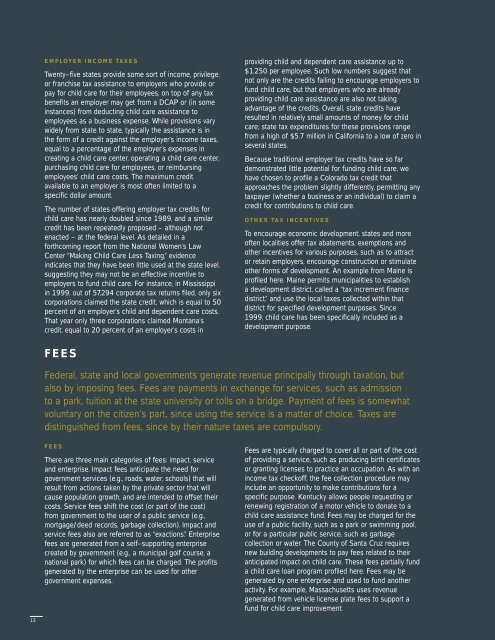Financing Child Care in the United States - Ewing Marion Kauffman ...
Financing Child Care in the United States - Ewing Marion Kauffman ...
Financing Child Care in the United States - Ewing Marion Kauffman ...
Create successful ePaper yourself
Turn your PDF publications into a flip-book with our unique Google optimized e-Paper software.
EMPLOYER INCOME TAXES<br />
Twenty–five states provide some sort of <strong>in</strong>come, privilege,<br />
or franchise tax assistance to employers who provide or<br />
pay for child care for <strong>the</strong>ir employees, on top of any tax<br />
benefits an employer may get from a DCAP or (<strong>in</strong> some<br />
<strong>in</strong>stances) from deduct<strong>in</strong>g child care assistance to<br />
employees as a bus<strong>in</strong>ess expense. While provisions vary<br />
widely from state to state, typically <strong>the</strong> assistance is <strong>in</strong><br />
<strong>the</strong> form of a credit aga<strong>in</strong>st <strong>the</strong> employer’s <strong>in</strong>come taxes,<br />
equal to a percentage of <strong>the</strong> employer’s expenses <strong>in</strong><br />
creat<strong>in</strong>g a child care center, operat<strong>in</strong>g a child care center,<br />
purchas<strong>in</strong>g child care for employees, or reimburs<strong>in</strong>g<br />
employees’ child care costs. The maximum credit<br />
available to an employer is most often limited to a<br />
specific dollar amount.<br />
The number of states offer<strong>in</strong>g employer tax credits for<br />
child care has nearly doubled s<strong>in</strong>ce 1989, and a similar<br />
credit has been repeatedly proposed – although not<br />
enacted – at <strong>the</strong> federal level. As detailed <strong>in</strong> a<br />
forthcom<strong>in</strong>g report from <strong>the</strong> National Women’s Law<br />
Center “Mak<strong>in</strong>g <strong>Child</strong> <strong>Care</strong> Less Tax<strong>in</strong>g,” evidence<br />
<strong>in</strong>dicates that <strong>the</strong>y have been little used at <strong>the</strong> state level,<br />
suggest<strong>in</strong>g <strong>the</strong>y may not be an effective <strong>in</strong>centive to<br />
employers to fund child care. For <strong>in</strong>stance, <strong>in</strong> Mississippi<br />
<strong>in</strong> 1999, out of 57,294 corporate tax returns filed, only six<br />
corporations claimed <strong>the</strong> state credit, which is equal to 50<br />
percent of an employer’s child and dependent care costs.<br />
That year only three corporations claimed Montana’s<br />
credit, equal to 20 percent of an employer’s costs <strong>in</strong><br />
provid<strong>in</strong>g child and dependent care assistance up to<br />
$1,250 per employee. Such low numbers suggest that<br />
not only are <strong>the</strong> credits fail<strong>in</strong>g to encourage employers to<br />
fund child care, but that employers who are already<br />
provid<strong>in</strong>g child care assistance are also not tak<strong>in</strong>g<br />
advantage of <strong>the</strong> credits. Overall, state credits have<br />
resulted <strong>in</strong> relatively small amounts of money for child<br />
care; state tax expenditures for <strong>the</strong>se provisions range<br />
from a high of $5.7 million <strong>in</strong> California to a low of zero <strong>in</strong><br />
several states.<br />
Because traditional employer tax credits have so far<br />
demonstrated little potential for fund<strong>in</strong>g child care, we<br />
have chosen to profile a Colorado tax credit that<br />
approaches <strong>the</strong> problem slightly differently, permitt<strong>in</strong>g any<br />
taxpayer (whe<strong>the</strong>r a bus<strong>in</strong>ess or an <strong>in</strong>dividual) to claim a<br />
credit for contributions to child care.<br />
OTHER TAX INCENTIVES<br />
To encourage economic development, states and more<br />
often localities offer tax abatements, exemptions and<br />
o<strong>the</strong>r <strong>in</strong>centives for various purposes, such as to attract<br />
or reta<strong>in</strong> employers, encourage construction or stimulate<br />
o<strong>the</strong>r forms of development. An example from Ma<strong>in</strong>e is<br />
profiled here. Ma<strong>in</strong>e permits municipalities to establish<br />
a development district, called a “tax <strong>in</strong>crement f<strong>in</strong>ance<br />
district,” and use <strong>the</strong> local taxes collected with<strong>in</strong> that<br />
district for specified development purposes. S<strong>in</strong>ce<br />
1999, child care has been specifically <strong>in</strong>cluded as a<br />
development purpose.<br />
FEES<br />
Federal, state and local governments generate revenue pr<strong>in</strong>cipally through taxation, but<br />
also by impos<strong>in</strong>g fees. Fees are payments <strong>in</strong> exchange for services, such as admission<br />
to a park, tuition at <strong>the</strong> state university or tolls on a bridge. Payment of fees is somewhat<br />
voluntary on <strong>the</strong> citizen’s part, s<strong>in</strong>ce us<strong>in</strong>g <strong>the</strong> service is a matter of choice. Taxes are<br />
dist<strong>in</strong>guished from fees, s<strong>in</strong>ce by <strong>the</strong>ir nature taxes are compulsory.<br />
FEES<br />
There are three ma<strong>in</strong> categories of fees: impact, service<br />
and enterprise. Impact fees anticipate <strong>the</strong> need for<br />
government services (e.g., roads, water, schools) that will<br />
result from actions taken by <strong>the</strong> private sector that will<br />
cause population growth, and are <strong>in</strong>tended to offset <strong>the</strong>ir<br />
costs. Service fees shift <strong>the</strong> cost (or part of <strong>the</strong> cost)<br />
from government to <strong>the</strong> user of a public service (e.g.,<br />
mortgage/deed records, garbage collection). Impact and<br />
service fees also are referred to as “exactions.” Enterprise<br />
fees are generated from a self–support<strong>in</strong>g enterprise<br />
created by government (e.g., a municipal golf course, a<br />
national park) for which fees can be charged. The profits<br />
generated by <strong>the</strong> enterprise can be used for o<strong>the</strong>r<br />
government expenses.<br />
Fees are typically charged to cover all or part of <strong>the</strong> cost<br />
of provid<strong>in</strong>g a service, such as produc<strong>in</strong>g birth certificates<br />
or grant<strong>in</strong>g licenses to practice an occupation. As with an<br />
<strong>in</strong>come tax checkoff, <strong>the</strong> fee collection procedure may<br />
<strong>in</strong>clude an opportunity to make contributions for a<br />
specific purpose. Kentucky allows people request<strong>in</strong>g or<br />
renew<strong>in</strong>g registration of a motor vehicle to donate to a<br />
child care assistance fund. Fees may be charged for <strong>the</strong><br />
use of a public facility, such as a park or swimm<strong>in</strong>g pool,<br />
or for a particular public service, such as garbage<br />
collection or water. The County of Santa Cruz requires<br />
new build<strong>in</strong>g developments to pay fees related to <strong>the</strong>ir<br />
anticipated impact on child care. These fees partially fund<br />
a child care loan program profiled here. Fees may be<br />
generated by one enterprise and used to fund ano<strong>the</strong>r<br />
activity. For example, Massachusetts uses revenue<br />
generated from vehicle license plate fees to support a<br />
fund for child care improvement.<br />
13
















